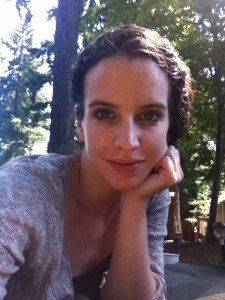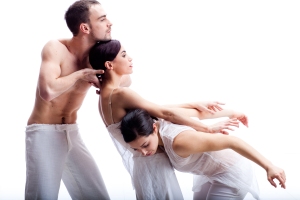
Guadalupe in "Danzon". Photo by Cheryl Mann.
Saturday marks the first performance of her 10th season with Luna Negra and Veronica Guadalupe is ready. After two major injuries during her career, she’s at the top of her game and excited about the upcoming performance ¡Mujeres! at the Harris Theater. The program celebrates Latina women with three pieces: a restaging of a work Paloma Querida, inspired by Mexican painter Frida Kahlo; a premiere about the first pre-modern queen of Spain; and another premiere inspired by a photo by Mexican photographer Graciela Iturbide.
Guadalupe has been dancing since she was 2 1/2 years old and studied at the Virginia School for the Arts, danced in the second company with Giordano Jazz Dance Chicago and was an apprentice with River North Dance Chicago before joining Luna Negra in 2002. She’s now also co-rehearsal director, was one of the dancers to stay with the company after founder Eduardo Vilaro left in 2009 to run Ballet Hispanico in New York and current Artistic Director Gustavo Ramírez Sansano took over. I spoke with her two weeks ago about the transition, the company and her career.
How did you end up at Luna Negra?
I apprenticed with River North for a year and I sustained a really terrible injury when I was there. I fractured my tibia almost all of the way through and I have a titanium rod in there now. They think that I probably had a stress fracture that I danced on for at least three months. I was out for six months. After that, my leg was a noodle. I’d been on crutches for 12 weeks and in a cast for another 10 weeks…it was terrible. I was barely taking barre again when my friend wanted us to go and audition for Luna Negra. Are you kidding me? When we got to rep, luckily, everything was on the other leg! He (Vilaro) offered me a contract and I had to tell him I hadn’t danced in six months, but he was willing to give me a try. That was July 2002.
Tell me about the transition. When Eduardo left, you were one of the only people who stayed…
I’d left for a brief period of time, while the transition was happening. When Eduardo announced he was leaving, almost immediately Michelle Manzanales and another board member contacted me and wanted me to come back. I did a fall season as a guest artist and I was part of the search for the new Artistic Director. I was the only one to have worked with all of the candidates. I could tell the dancers what it was like to work with them and tell the board and search committee what my experiences had been with these people. I told them flat out there was only one person I would come back for. Gustavo choreographed on us in 2002 and he worked with us two other times. I said, he’s the only person who can take the company to the next place. He was my choice. I told the board that this is what the company needs. It worked out perfectly.
The company looks completely different now. How was the transition?
The transition was really smooth, because we did have a change over with dancers too, so we had a lot of new people starting over. I think that was really important. When we signed him, he couldn’t come here for a few months and I think a lot of dancers were thinking selfishly about what they would do in the meantime, instead of what would be good for the company as a whole. I think it was important to have a group of dancers that could begin new with this new era.
How do you like the difference in style of dancing?
I love it. I think it’s fresh and new and exciting. I think it’s shaking up the Chicago dance community. It’s something they haven’t seen before and no one else is doing it. It’s incredible.
Let’s talk about your dancing. Are you in all three pieces in !Mujeres!?
Yes. I’m resetting “Paloma Querida”. Michelle (Manzanales) came in for a weekend and worked with us. She made a lot of changes. It’s almost like a new piece now. The heart of it is still there, but she did a lot of structural changes that I think made a big difference. She was very respectful that these weren’t the same group of dancers that I worked with before and let’s utilize what we have now. She made some really great changes.
Tell me about the two world premieres.
“Juana” – oh, I’m Juana! – she was the first queen of modern Spain. Her story is she fell in love with this guy Phillipe. They called her Juana Loca and he was Phillipe Hermosa. Phillip the beautiful and Juana the crazy. She was crazy in love with him and he cheated on her left and right. When he died, she went totally crazy and was obsessed with him even though he was dead. It drove her mad. Her family left her. The country wouldn’t entrust her with the power of being queen, so they locked her in a tower to die.
Do you get a crazy Spanish Giselle mad scene?
Kind of. It’s a hard balance. At first, I was focusing more on the emotional and dramatic aspect of it and then she (Asul Noales) threw a whole bunch of dance in. I don’t leave the stage for 21 minutes. It’s intense.
(Gustavo’s piece) “Not Everything” is inspired by a female photographer. It’s just so beautiful. The music…it a very intense piece musically. There’s a really soft beginning with just Mónica (Cervantes) and Renée (Adams) that lays the groundwork from the picture. The group section is…it’s the hardest thing I’ve ever done in my life. It’s so fast. We were watching rehearsal footage the other day and someone said it looked like it was in fast forward. It feels like it’s in fast forward! This is the test, the challenge…he’s throwing the hardest thing at us right now, because we have to get it. We’re performing it in a couple of weeks. The third section is the most beautiful music and it totally changes directions.
Luna Negra – ¡Mujeres!, Saturday, October 1, 2011 @ 630pm
Harris Theater, 205 E Randolph, 312.334.7777
 Dancer Renee Adams opens up about the end of Luna Negra Dance Theater and what she’s up to now.
Dancer Renee Adams opens up about the end of Luna Negra Dance Theater and what she’s up to now.

